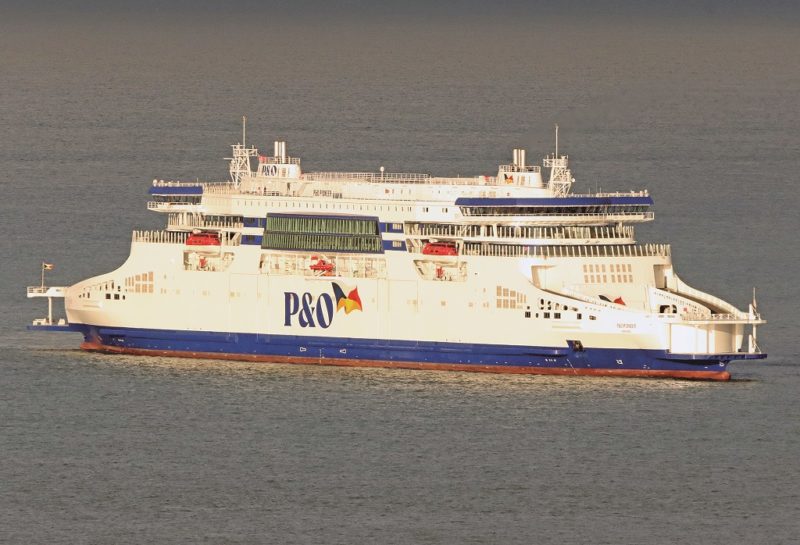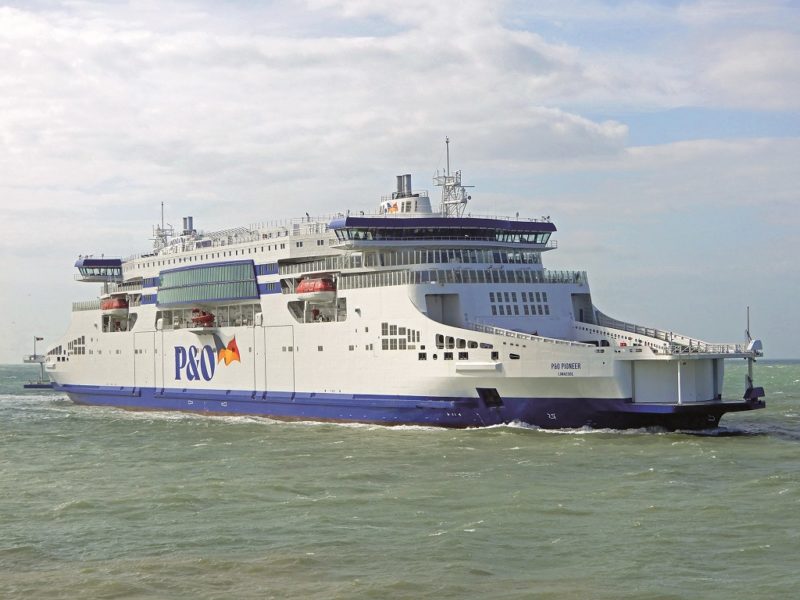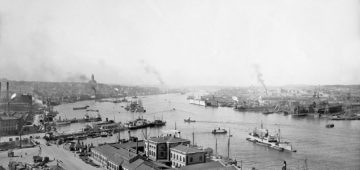The double-ended vehicle ferry is a common enough sight but, more often than not, these have a wheelhouse located centrally above the car deck/passenger accommodation. A slightly less common variant is the double-ended ferry that has a wheelhouse/bridge at each end. The first such example that the Writer can recall was the 1,858gt/1974-built Netley Castle of Red Funnel Ferries, which served Southampton-Cowes from 1974 until 1996. The 73.8m long vessel was later dubbed “the ship that never turns around” when one hydraulic prow was removed and replaced by a gate to fit the Southampton linkspan, meaning she could only berth that way around. The ship shared the Solent waters with examples of the aforementioned double-ended ferry format. The Netley Castle survives to this day as the Sis of Jaroldlinja in Croatia. Larger still examples of ferries with two wheelhouses include ForSea’s 11,046gt/1992-built/111m long Aurora, the 10,067gt/1997-built/112m long Hamlet and the 11,434gt/1991-built/111m long Tycho Brahe from the Helsingborg-Helsingor service, TESO’s Texel ferries Dokter Wagemaker (13,256gt/built 2005/130m long) and 15,483gt/2016-built and 135m long Texelstroom, the multi-generational fleet of Staten Island ferries, including the 5,919gt/2021-built/97m long Michael H. Ollis plus past and present members of the BC Ferries fleet, including the 6,422gt/1976-built and 139m long Queen of Alberni and the 21,777gt/2008-built and 160m long Coastal Celebration.
It is fair to say that the true double-ended “push-pull” style design of ship, with two bows and two navigation bridges, is generally found in coastal waters but, in 2019 and after much discussion and designing, an ocean-going class of double-ended vehicle ferry was born, the Fusion Class, for P&O Ferries’ Dover-Calais service across the Straits of Dover, a project with a £220 million price tag. Arguably the most notable mould-breaker since the original Spirit Class (13,601gt/1979-1980) and Chunnel Beaters of 1987 (26,433gt Pride of Dover/Pride of Calais) that were spawned by Townsend Thoresen, the 47,653gt/2023-built, 230.50m long and 30.80m beam P&O Pioneer became a reality rather than just an artist’s impression when she was launched as Yard No. Guangzhou 19121007 on 2nd January 2022 at the Guangzhou Shipyard International Co. Ltd in Guangzhou, China. The sistership, P&O Liberté, will follow towards the end of 2023 but the P&O Pioneer was delivered to DP World France SAS on 28th February 2023 as a new era of ferry travel between Dover and Calais and a radical shift away from the conventional ships. The newbuild also heralded a revised naming policy for the P&O Dover ships with the P&O Pioneer being the first vessel in the fleet to have the name of the company as a prefix. As you would expect, the name Pioneer was selected as she is the first of a new generation of RoPax ferry to be introduced on the Dover Strait. Once afloat, the P&O Pioneer became not only a first in class but the world’s largest double-ended vehicle ferry. Sea trials had commenced from Nansha on 23rd September 2022 (4 days) followed by 13th November 2022 and 24th December 2022-8th January 2023. The delivery voyage commenced on 3rd March 2023 with Captain Simon Moore in command via Singapore (7th March), Colombo (11th-12th March), Suez Canal (20th March), Limassol, Cyprus, (22nd March), Gibraltar (27th March), Poole Bay (30th March) and Sandown Bay, Isle of Wight (1st/2nd April) before an arrival at Dunkerque East on 4th April 2023 as the 28,138gt/1993-built Pride of Burgundy departed for Aliaga, Turkey, at the end of her career at sea. The P&O Pioneer had to proceed to the French port instead of a grand homecoming at Dover due to a fault with a lifeboat davit system onboard during routine safety drills conducted in Sandown Bay. The vessel then remained in port until 4th June when she conducted berthing trials at Calais before making her long awaited debut at Dover the next day.
BLENDING IN
Having been deferred from May Day 2023, the P&O Pioneer finally got her maiden service voyage on 19th June 2023 when she sailed on the 09.55 departure from Dover. The trained eye will note that the double-ended ship offers an asymmetrical (unbalanced) appearance. Unlike the traditional ship types, and even other double-ended designs, the Fusion Class vessels do not have a true bow or stern. The Calais end is referred to as the bow for the purpose of the ship’s plans and for dry docking. Visually, the Calais end can always be identified by the fact that the lifeboats face that way. The bow spades are different for both ports too, the larger being at the Dover end. For versatility purposes, the spades can be changed to enable the ship to berth “wrong way” at either port. The Spirit Class ships Spirit of Britain (47,592gt/built-2011) and Spirit of France (47,592gt/built 2012) are only able to berth port side at Dover and starboard side at Calais as their docking arrangements are fixed and cannot be altered. Many of the key design features from the Spirit Class have been incorporated into the Fusion Class plus not having to swing 180 degrees upon departure from Calais and upon arrival at Dover will offer time savings of an estimated 7 minutes and a reduction in fuel consumption of one sixth on a per voyage basis. The newbuilds are also said to have a reduced carbon footprint with carbon emissions cut by 40% compared to the ferries that they replace, the Darwin Class duo Pride of Canterbury (30,635gt/built 1991) and the 30,635gt/1992-built Pride of Kent. These ships began life as the 22,986gt Dover-Zeebrugge Superfreighters European Pathway and European Highway before conversion to full RoPax mode for Dover-Calais in 2003. The Pride of Kent bowed out of service in June and went to layup in Tilbury Docks on the River Thames on 14th July after an early morning departure from her former homeport. Back to the Fusion Class and, upon making her debut, the P&O Pioneer also became the first English Channel ferry to use pod propulsion and the first hybrid ferry to operate between England and France. Besides being 230.50m long with a 31.40m extreme beam, the ship’s other vital statistics include a moulded hull depth of 9.80m, a maximum draught of 6.70m, a displacement of 27,836.1 tonnes and a windage area of 5209.6m2 (at 6.70m draught). The deadweight capacity is 8,850dwt and the net tonnage is 16,754nt.
The P&O Pioneer has a hybrid diesel-electric propulsion system installed, consisting of a quartet of Wärtsilä 16V31 diesel engines that have a total power output of 30,000kw/ 40,240hp.The Wärtsilä 31 series of engines set a benchmark for medium-speed units in terms of efficiency and overall emissions performance, offering the best fuel economy of any 4-stroke engine in its class across the complete operating range. It is available in 8-to-16-cylinder configurations with a power output from 4.2 to 10.4 MW at 720 and 750rpm. A 16-cylinder 31 Series engine is 8,962mm long with an overall height of 4,572mm, a width of 3,500mm and weighs 92.50kg. The cylinder bore is 310mm and the piston stroke is 430mm. Each engine also features ABB turbochargers and Wärtsilä AI technology. The Fusion Class ships also have a battery capacity of 8.80 MWh that consists of 1,160 large-scale batteries from XALT Energy containing 6,960 cells in 290 subpacks and housed in four battery rooms. The batteries are charged by the vessel’s engines with battery power employed at each port and for peak saving purposes, assisting the main engines when under heavy load. Plug-in charging facilities will be used at Dover and Calais when the port authorities eventually install them.
The media circus and Keyboard Experts on social media misunderstood the situation completely and claimed that the ships were being introduced when not able to charge the batteries. This was false as the newbuilds can do that themselves with each vessel also being future-proofed to become carbon-neutral. This will be achieved by installing extra battery capacity once the aforementioned plug-in facilities are available. There is no mechanical connection between the main engines and the propulsion on each ship due to the diesel-electric/battery hybrid nature of the system. The Fusion Class ferries are the first ever to be outfitted with two 7.50 megawatt Azipods at each end, a configuration that enables an operating speed of 20.8 knots. Each ABB DO1600 pod has a 4m diameter, 5-bladed propeller and can be turned in any direction. The Azipod D Series for open water is a second-generation compact size that encompasses the power range of 1 MW to 7.5 MW. The D series technology combines the best features of the original C series and the high-powered XO series and is the most efficient azimuthing propulsor in its power range, with excellent course-keeping characteristics. Based on its gearless construction and high performance, the DO1600 provides cost-efficient, reliable and energy saving operations for not only ferries but also cruise, offshore and special vessels. The high performance of the thruster is achieved by a unique hybrid cooling of the propulsion motor combining a direct cooling to the surrounding sea water and an active air-cooling system. The use of Azipods greatly enhances manoeuvrability and negates the need for rudders or bow or stern thrusters. Energy saving onboard is also enhanced by a heat recovery system. There is also a high degree of automation through the vessels’ systems with over 12,000 alarm points built in. The shipyard was also pleased to highlight that these vessels can instantly switch between diesel and battery power at the push of a single button. The ship’s dead slow operation is 11.8 knots, the minimum speed to maintain a course is 5 knots, the full ahead to full astern response time is 5-6 minutes and a pod takes just 15 seconds to turn 180 degrees in manoeuvring mode. If required, a crash stop is performed only with the aft Azipod units. The machinery spaces are located on Decks 1 and 2, including two propulsion rooms, two engine rooms, 2 auxiliary rooms, 2 A/C compressor rooms and a trailer lift.
A PURPOSEFUL MIXTURE
Like the Spirit Class before them, the Fusion Class ships offer 3 vehicle decks. Deck 3 is the main freight deck with 1,319 lanemetres of capacity for around 77 HGVs, mostly parked in 4 lanes either side of the central casing. The lanes are 3.2m wide except for the lane either side of the centre casing, which is 3.0m wide. The clear height of the lower deck is 5.00m, the ship/shore access is 10.7m wide and 5m high whilst the pair of shell doors at each end are 5.7m wide and 5m high per door. Above on Deck 5 is the upper freight deck with a 1,278 lanemetre capacity for around 76 HGVs, including 6 carried outside on both the forward and aft weather decks. As with Deck 3, the lanes are 3.2m wide except for the lane either side of the centre casing, which is 3.0m wide. The clear height of the upper vehicle deck is 4.80m. Decks 3 and 5 are accessed via the double tier linkspans at both ports with the Deck 3 clear width being 9.4m and 9.60 on Deck 5. Deck 3 has hydraulic clam shell doors and watertight inner doors whilst the vehicle garage on Deck 5 has two-piece folding weather doors at either end that open vertically. The latter measure 12.2m wide and 4.8m high. Either side of the access to the Deck 5 garage is a gentle and curving fixed ramp that leads up to the Deck 7 car garage.

Various specifications give the garage as having space for 194 cars (800 lanemetres) but diagrams indicate a maximum of 258 cars/1,066 lanemetres. The passenger accommodation is on Decks 8 and 9 with around 1,550m2 of public spaces. The layout of the facilities is asymmetric with more of a “bow to stern” feel. Double-height windows span both decks in a convex arrangement, dominating the centre of each side of the vessel, giving passengers excellent sea views.
On Deck 8, at the Calais end, is a 105-seater external Lounge Deck that wraps itself around the profile of the superstructure with a 287-seat bar lounge inside. The mid-ships area, indicated by the panoramic windows, houses the 410-seater Food Market. This provides P&O’s ‘grab and go’ concept of boxed up hot and cold items and has self-service tills too. In the Dover end of Deck 8 is the full-width 588m2 World Duty Free shop with a 120-seat external promenade deck beyond. The passenger services desk is also mid-ships on Deck 8 plus there is a play area and a gaming area. Up on Deck 9 at the Calais end is the 69-seat external Driver’s Lounge Deck on the port side (with smoking area) and the 53-seat external Pet Lounge Deck on the starboard side, separated by a partition. The latter also has a dog toilet area and both deck sections offer superb sea views. Behind these respective areas indoors are the 128-seat Driver’s Lounge and 117-seat Pet Lounge. Mid-ships on the port side is the 132-seat Driver’s Dining restaurant plus male/female changing and shower rooms, galley and scullery. Aft of the restaurant is one of two Quiet Lounges (107 seats) with views out via the glass wall. Entry to the Quiet Lounges is £8 per person whilst access to the Driver’s area is governed by a barcode system and there is also a charge for the Pet Lounge. Starboard side behind the glass wall is The Kitchen self-service restaurant (188 seats plus a 25-seat family area which opens after 11am). On the port side towards the Dover end is the other Quiet Lounge (90 seats) and this also has a 20 seat outside deck. Adjacent to the Quiet Lounge on the starboard side is a 55-seat Club Lounge dining area, part of the most luxurious premium lounge available on the English Channel, surpassing that of the Darwin twins.
There is a selection of hot dishes available on a self-service basis and it is only here that the meals are available using traditional crockery and cutlery. A sign of the times perhaps. The Club Class charge is £24 per person. The remainder of this deck is occupied by the 128 seat Club Class Lounge (seating) and the wrap around promenade deck outside (120 seats) is also exclusively for Club Class guests. If the writer’s maths is any good, it would appear the indoor seating on Decks 8/9 totals 1,642 seats with a further 487 seats outside. A vast improvement on her fleetmates and the return of forward-facing promenade decks on a P&O Ferries vessel for the first time since the withdrawal of the Supervikings at Portsmouth is also very welcome. The latter examples ended their Channel careers in 1994 (Pride of Winchester/Cherbourg II, built as Viking Viscount/Voyager) and 2002 (Pride of Cherbourg/Hampshire, built as the Viking Valiant/Venturer).
In terms of outside deck space, the ship offers the most of any Dover-based ferry thus far, with only the classic style of the 28,833gt/1992-built Isle of Innisfree coming close. The décor has a subtle, Scandinavian feel and many of the passenger areas were installed by North Sea Offshore Technology (NSO), a ferry and offshore industry turnkey interior contractor. They’re based in Yantai, China, with other bases in Sweden, Estonia and Malaysia.
Deck 10 is the crew deck, with navigation bridge at each end. At the Calais end are the cabins for the captain (x2 – 33m2 and 25m2), Chief Engineer (33m2), Senior Officer (x5, each 25m2), Officer (x3) and Crew (x1). A further 8 Officer cabins are along the port side with 30 crew cabins along the starboard side and a further 10 port side aft. The portside also offers a 146m2 Officer and Crew Mess, a 36m2 Officer’s Day Room, a 65m2 Crew Day Room plus a 38m2 Games Room, a shop and the pantry/scullery. On the starboard side. Adjacent to the crew cabins, is the 42m2 Male Changing Room, the 39m2 Female Changing Room, a sauna, a 48m2 gymnasium, a meeting room, a 10m2 office plus crew and officer laundry/drying facilities. A 49m2 Ship’s Office is located portside forward in this area, aft of the Officer’s accommodation. Other facilities on this deck include the emergency generator room, 16m2 Carpenter and Electrical Workshops plus three cabins for Contractors. Deck 11 houses various services including fans and an emergency generator plus there is an outside deck area for crew on the portside. Last but not least, Deck 12 has a heli-pad midships, suitable for a Sikorsky S-92 coastguard helicopter plus the funnels, one behind each wheelhouse.
CELEBRATORY UNION
On 26th July the P&O Pioneer was back in the limelight for her official naming ceremony at Dover’s Cruise Terminal 1. Around 120-150 invited guests assembled in the terminal for 2pm before gathering on the quayside, seated on a mobile grandstand in front of a stage, with the ship as a backdrop. The proceedings were hosted by Ross Barrett, Ship of the Future Programme Director with speeches by CEO Peter Hebblethwaite and Robert Woods before the baptising ceremony was undertaken by the Rev. Canon Andrew Wright. The ship’s Godmother was Georgie Woods and there was a heart-stopping pause between the ceremonial ribbon being cut and the bottle smashing on the “bow”, the Dover end in the case of this double-ended ship!. The ship’s whistle was sounded, accompanied by a fanfare and the firing of a confetti canon, all P&O house colours of course. Guests then embarked the ship at Deck 3 and attended a welcome by the Captain, Simon Moore, who had been involved in the Fusion Class project pretty much from day one, and the ceremonial cake was cut by the Godmother using a ceremonial sword. Guests disembarked by 6pm and the ship then returned to her working life.







Comments
Sorry, comments are closed for this item